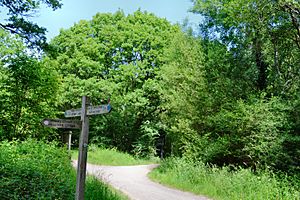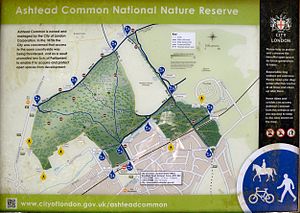Ashtead Common facts for kids
Ashtead Common is a large, beautiful woodland area in England, just north of the village of Ashtead. It's about 495 acres (200 hectares) big and is open for everyone to explore! The City of London Corporation, a group that manages many parks and open spaces, owns and looks after the common. A big part of Ashtead Common, about 180.5 hectares, is a special place called a National Nature Reserve. This means it's protected because of its important wildlife and habitats. Ashtead Common is also connected to Epsom Common, and together they form a larger area known as Epsom and Ashtead Commons. This whole area is recognized as a Site of Special Scientific Interest because of its unique nature.
Contents
Why Ashtead Common is Special
Ashtead Common is super important for nature! It's been part of the Epsom and Ashtead Commons Site of Special Scientific Interest (SSSI) for a long time. An SSSI is a place chosen because it has some of the best examples of wildlife, geology, or landforms in the country. For Ashtead Common, it's special because of the many different kinds of birds that live and breed there.
It's also a National Nature Reserve (NNR), which is an even higher level of protection. This is because of its amazing ancient trees and the rare creatures that live in them.
Ancient Trees and Rare Animals
Ashtead Common is home to over 2,300 pollarded oak trees. These trees are very old, between 300 and 400 years old! Pollarding is a special way of cutting trees that helps them grow for a very long time and creates lots of nooks and crannies. These old trees, especially their decaying wood, are perfect homes for many rare and endangered species of invertebrates (creatures without backbones, like insects). This makes the common a really important place for conservation, not just in Britain but across Europe!
Besides the ancient trees, you can also find areas of bracken (a type of fern), scrubland, grassy fields, and various water habitats like ponds. These different areas mean even more types of plants and animals can live there.
Dealing with Invasive Plants
Sometimes, plants that aren't native to an area can spread too much and cause problems for other plants. On Ashtead Common, a plant called Michaelmas daisy started to take over. Experts tried different ways to control it. They found that letting goats graze (eat the plants) was the best way to manage the Michaelmas daisies and help the native plants grow better.
Hidden History
Ashtead Common isn't just about nature; it also has a fascinating history! You can find the remains of a Roman villa (an ancient Roman house) and old tile works on the common. These are protected as scheduled ancient monuments, meaning they are important historical sites. There are also some earthworks, which are old mounds or ditches made by people long ago.
In the 1930s, there were plans to build a railway line across the common. However, World War II started, and then the idea of a "Green Belt" was introduced. A Green Belt is a policy to stop cities from spreading too much and to keep open spaces. Because of this, the railway was never built. Part of the land that was set aside for the railway was later used to build the M25 motorway.
How to Visit Ashtead Common
Ashtead Common, along with Epsom Common, stretches from Junction 9 of the M25 motorway near Leatherhead all the way to the edge of Epsom. There are many different entrances you can use to walk onto the common, including from north Ashtead and Epsom.
A long-distance walking path called the Thames Down Link crosses the western part of the common. This path goes from Kingston upon Thames to Box Hill station, so you can enjoy a long walk through the beautiful scenery of Ashtead Common as part of a bigger adventure!



